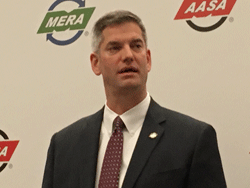Bill Long, president of the Automotive Aftermarket Suppliers Association (AASA), and Brian Daugherty, chief technology officer of the Motor & Equipment Manufacturers Association (MEMA), discussed the challenges of advanced vehicle technologies during the AASA Member & Media Briefing this morning prior to the kickoff of AAPEX 2016.
Because of this, AASA and MEMA identified advanced technologies as one of the key strategic drivers for the association in its mission to advance suppliers’ business interests.
“A more connected car could lead to an increase in key business drivers for the aftermarket,” Long said. “It will lead to increased awareness of failure and replacement rates, and prognostics that alert both motorists and service providers of pending failure. More end-consumer awareness would allow for increased maintenance performed on vehicles.”
Long outlined four “vital steps” to secure the aftermarket’s future:
• Clearly defining what the industry wants. It’s more than data ownership for motorists – it’s retaining freedom of choice for vehicle repair and replacement parts.
• Collaborating with OEMs on viable technical solutions.
•Developing “connected-vehicle” training and certification for shops to show the public and regulators the industry is prepared.
• Grass-roots awareness.
The industry is united in its goal of freedom of choice for vehicle repair and service parts, Long said.
Daugherty discussed fuel economy standards, vehicle-to-vehicle (V2V) communications, cybersecurity and automated and autonomous vehicle technology. Daugherty was hired by MEMA in January and previously worked at Visteon Corp., where he helped develop blind spot detection systems for Honda and Chrysler, and a steer-by-wire system for Chevrolet.Corporate average fuel economy requirements will increase dramatically during the next 10 years and an increased focus on lightweighting vehicles will result in the redesign of many existing OE and aftermarket parts, he said. The impact on suppliers will be positive because these trends will result in more complex, highly engineered and higher value OE and aftermarket parts.
“V2V is a 5.9 GHz two-way radio and GPS-based technology that promises to significantly reduce collisions by allowing vehicles to ‘see’ other vehicles at ranges beyond what can be achieved by radar, LIDAR (light detection and ranging) and camera systems,” Daugherty said. “NHTSA projects that V2V systems will help in 80 percent of non-impaired crashes and we are awaiting the release of their proposed rulemaking that will most likely require V2v capability in all new vehicles.”
Aftermarket systems will play a large role in the success of the system because V2V’s value depends on the percentage of surrounding vehicles that are similarly equipped. With more than 260 million non-V2V equipped vehicles on the road today, upgrading as many of those vehicles as possible will reduce crashes and fatalities, he said.
Low-level automated driver assist systems are available now, but fully autonomous or driverless vehicles are “quite a long way off except in controlled environments,” Daugherty said. “However, we should not let the hype surrounding autonomous vehicles distract us from the near-term safety benefits of V2V communication and driver assistance technologies.” As these systems become more prevalent, repair facilities will need to perform repairs and alignments on an array of radar and vision sensors.
As vehicles become more connected with automated features, cybersecurity becomes critical, he said. “The threat is real and as is the case with networked computers today, it will be a serious and ongoing issue – forever. Current vehicle networks were not designed to be plugged into the outside world and therefore pose a risk. Automated vehicle systems that control the steering and braking also provide a new level of safety risk if a cyber-attack occurs.”
OEMs, suppliers, and the federal government are working together to try to understand and address potential threats and move the industry to “secure by design” architectures, he said. For the aftermarket, the main issue is how to keep vehicles cyber-secure without locking out the aftermarket.
In other news:
• Long said that 2016 has been a great year for the aftermarket, which will be a $268 billion industry by the end of 2016. Despite that, significant opportunities exist due to an estimated $67 billion in unperformed or deferred maintenance.
• Motor & Equipment Remanufacturers Association (MERA) President and COO John Chalifoux announced that the organization launched a “Manufactured Again” certification program to help buyers purchase remanufactured products with like-new quality and warranty coverage. Click here to see the entire article.
Subscribe to Aftermarket Business World and receive articles like this every month….absolutely free. Click here.



